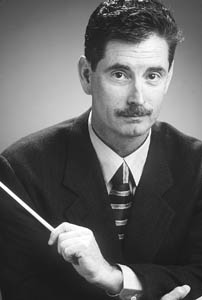![[Metroactive Music]](/music/gifs/music468.gif)
[ Music Index | Santa Cruz Week | SantaCruz Home | Archives ]
'Blue' Streak
The SC Symphony takes some inspiration from Bonds and hits its opener out of the park
By Scott MacClelland
John Larry Granger took obvious inspiration from Barry Bonds' entry into the real 700 Club. He opened his new Santa Cruz Symphony season with a home run. But Granger didn't hit it. His soloist, pianist Stephen Prutsman, did, in a Rhapsody in Blue that brought Saturday's Civic Auditorium audience to its feet, hollering and cheering for more. What music director wants less from his opening night, however it comes?
Prutsman's impulsive and explosive survey of the great American classic electrified the room, audience and orchestra alike. Despite some hammering on his part, and an acoustic that robbed the Steinway of its richer sonorities, Prutsman tore into a vividly personal account of George Gershwin's audacious 1924 breech entry into the concert world.
Gershwin's original performance was recorded at Aeolian Hall and Paul Whiteman's band plays it with lots of saucy attitude. While the symphony played it without those Brooklyn inflections, Granger himself showed a keen sense of the piece, getting his players into the swing. To reward his gushing fans, Prutsman came back for a shrewdly crafted and flamboyantly delivered jazz arrangement based on "Five Foot Two, Eyes of Blue," Ray Henderson's popular ditty of the same vintage as the Gershwin.
Granger got the juices flowing, or rather the chuckles chuckling, with the concert opener, Charles Ives' Variations on "America" in the colorful orchestration by William Schuman. Ives was a mere youth of 17 when he drew up these mischievous variations for organ. (He was, after all, the son of a bandmaster who loved nothing more than the mellifluous timbres of a band playing out of tune.) Despite its basic wickedness, flavors of true patriotism shine through. Unfortunately--or perhaps fortunately given his prickly personality--Ives didn't live long enough to hear the Schuman.
For the second half, Granger took on Brahms' Symphony no. 1 in C Minor, it of the long gestation (20 years) and considerable inspiration. Recent research has shed valuable new light on the Brahms symphonies. For example, at the premiere of the C Minor, in 1876, he chose the orchestra at Karlsruhe, with just 49 players, including nine each first and second violins, four each violas, cellos and contrabasses. (The Santa Cruz Symphony string complement is larger.) But during Brahms' lifetime, orchestras grew to enormous size. When he conducted his second symphony at Hamburg, in 1878, he faced an ensemble of 113 players; with one wind per part, the increase of personnel was all in the strings. Moreover, Brahms preferred to use natural horns, narrow-bore trombones, leather-skinned timpani and gut E strings on the violins.
Granger's performance was smooth sailing in every movement but the first. Starting with the second, a palpable buildup of purpose and energy ensued. The chorale-dominated finale won audience cheers almost as frenzied as that following the Gershwin.
Copyright © Metro Publishing Inc. Maintained by Boulevards New Media.
For more information about Santa Cruz, visit santacruz.com.
![]()

Man Without Hat: We have managed to restrain ourselves from running yet again our favorite symphony picture ever, of John Larry Granger in a fez. After the amazing opening to the Santa Cruz Symphony's season last weekend, it's the least we could do.
From the September 22-29, 2004 issue of Metro Santa Cruz.